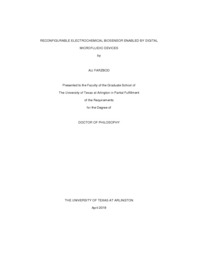
ATTENTION: The works hosted here are being migrated to a new repository that will consolidate resources, improve discoverability, and better show UTA's research impact on the global community. We will update authors as the migration progresses. Please see MavMatrix for more information.
Show simple item record
| dc.contributor.advisor | Moon, Hyejin | |
| dc.creator | Farzbod, Ali | |
| dc.date.accessioned | 2023-09-11T15:15:38Z | |
| dc.date.available | 2023-09-11T15:15:38Z | |
| dc.date.created | 2018-05 | |
| dc.date.submitted | May 2018 | |
| dc.identifier.uri | http://hdl.handle.net/10106/31691 | |
| dc.description.abstract | The increasing demand for improving the health care quality in developed countries with synchronous advances in the microfabrication of CMOS devices results in the emergence of the Lab-on-a-chip (LOC) field. The ultimate goal of LOC's is to achieve the complete integration of biomedical protocols, such as sample pre-processing and separation and analysis of biosamples on a chip.
Electrowetting on dielectric (EWOD) as a distinctive digital microfluidic (DMF) is capable of manipulating droplets less than a microliter along the electrode arrays by applying AC voltages. EWOD chips, as microfluidic platforms, are inherently electrical and do not have to deal with problems regarding a hydraulic system. Additionally, this feature makes them more compatible with control and feedback circuits while entailing their fabrication to be similar to well-developed CMOS fabrication. Another feature of these devices is the capability to control the very small volume of liquid (up to 900 nl), which becomes extremely important when working with expensive reagents, especially in bioanalysis.In the first part of this study, we present a demonstration of a reconfigurable potentiometric ion-selective electrode (ISE) array enabled by an electrowetting-on-dielectric (EWOD) microfluidic platform. This reconfigurability required the proposed sensor to be made on the EWOD chip and removed after use. The on-chip fabrication of the potassium ion-selective sensor includes electroplating Ag followed by forming an AgCl layer by chemical oxidation and forming a thin layer of polymer-based potassium ion-selective membrane on one of the sensor electrodes. The proposed device with the capability of on-chip ISE fabrication has many advantages such as automation, longer lifetime, minimal membrane and sample consumption, which makes it an outstanding candidate for a portable home-use device for regular measurements of human blood panels. In the second part of the study, the focus was on simultaneous measurement of potassium, sodium and calcium ions in a drop of emulated blood plasma sample via an EWOD microfluidic chip to deliver a showcase for the potential use of these devices for regular screening of blood panels such as electrolyte panels. In the last part of the study, we focused more on tackling a major problem of most biosensors known as immobilization. The goal was to eliminate the immobilization process on sensor electrodes by introducing a reconfigurable liquid-liquid electrochemical sensor which is compatible with EWOD platforms. In this sensor, at first, one droplet (ionic liquid) containing potassium selective Ionophore was dispensed over an interdigitated electrode. By acquiring a first electro impedance spectra (EIS) and fitting it to our equivalent circuit model, the initial values of electrical parameters of our modified ionic liquid were calculated. Then a drop of the sample solution containing the targeted biological molecule was dispensed over next to the modified liquid to create a liquid-liquid junction. Due to the specific affinity of the bio-receptor (i.e., biological recognition molecules), the targeted biomolecule will attach or transfer to the selective medium (i.e., modified droplet). Finally, by removing the sample liquid from the interface, we perform another EIS to find the secondary value of components of the equivalent circuit of modified liquid. The difference between the initial and secondary values of electrical elements correlated to the concentration of the targeted biomolecule in the sample solution. | |
| dc.format.mimetype | application/pdf | |
| dc.language.iso | en_US | |
| dc.subject | Electrowetting on Dielectric | |
| dc.subject | Digital Microfluidic device | |
| dc.subject | Electrochemical sensor | |
| dc.subject | Ion selective sensor | |
| dc.subject | liquid-liquid electrochemical sensor | |
| dc.subject | Lab on a chip | |
| dc.title | RECONFIGURABLE ELECTROCHEMICAL BIOSENSOR ENABLED BY DIGITAL MICROFLUIDIC DEVICES | |
| dc.type | Thesis | |
| dc.date.updated | 2023-09-11T15:15:38Z | |
| thesis.degree.department | Mechanical and Aerospace Engineering | |
| thesis.degree.grantor | The University of Texas at Arlington | |
| thesis.degree.level | Doctoral | |
| thesis.degree.name | Doctor of Philosophy in Mechanical Engineering | |
| dc.type.material | text | |
Files in this item
- Name:
- FARZBOD-DISSERTATION-2018.pdf
- Size:
- 2.805Mb
- Format:
- PDF
This item appears in the following Collection(s)
Show simple item record


